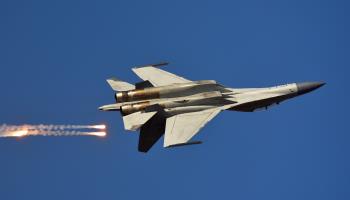Despite US technology export restrictions, China has enhanced its military AI capabilities
On October 28, the US Treasury Department issued final regulations restricting US investments in China’s artificial intelligence (AI), semiconductor and other advanced technology sectors, aiming to limit Beijing’s development of military AI capabilities. Military applications of AI are rapidly reshaping global power dynamics, as evidenced in the Russia-Ukraine and Israel-Hamas conflicts. Against this backdrop, the United States and China have intensified their competition to lead in the field.
What next
Subsidiary Impacts
- China’s defence sector could face short-term hurdles due to limited access to advanced AI systems.
- China’s military may accelerate domestic AI research to mitigate the effects of US restrictions, boosting domestic capabilities.
- Other countries may boost AI investments in their defence industries to keep pace with China’s advancements.
- US tech companies may face decreased revenues due to curtailed access to the Chinese market.
Analysis
In October, the Biden administration finalised restrictions on AI investments in China, which will become effective on January 2, 2025.
These measures stem from an August 2023 executive order aiming to prevent US investments from aiding “countries of concern” in developing military, intelligence and cyber capabilities. The restrictions target certain AI systems, as well as semiconductors, microelectronics and quantum information technologies. US Commerce Secretary Gina Raimondo stated that these rules are crucial to stop China from rolling out military-related technologies (see UNITED STATES: China AI rules – October 29, 2024).
Chinese military AI applications
China has a national strategy to develop military AI capabilities. A 2019 State Council white paper on national defence revealed “intelligent warfare” as a core component of the People’s Liberation Army’s (PLA) modernisation efforts, referring to integrating AI, quantum computing, big data and other emerging technologies. In 2022, President Xi Jinping called for the accelerated development of unmanned, intelligent combat capabilities, of which AI is an essential part.
Although China’s high-level goals for military AI are clear, it is difficult to assess the current capabilities of the PLA due to a lack of transparency. Researchers at Georgetown University’s Center for Security and Emerging Technology (CSET) analysed 343 PLA equipment contracts and, in February 2024, identified key areas where the PLA is making AI investments. These were:
- weapons systems;
- battlefield functions and support;
- intelligent and autonomous vehicles;
- intelligence, surveillance and reconnaissance;
- predictive maintenance and logistics;
- information and electronic warfare;
- simulation and training;
- command and control; and
- automated target recognition.
The US Department of Defense (DOD) believes China may be using generative AI for “cognitive warfare” or influencing the behaviour of adversaries overseas by generating online content.
In warfare, developing unmanned systems is one area upon which the country has placed significant emphasis. China has developed a series of intelligent unmanned vehicles, platforms and weapons, such as the Caihong, a series of unmanned aerial vehicles (or drones), and Lookout-II, an unmanned missile boat.
China also has a well-developed commercial drone manufacturing industry and is the top global exporter of military drones. The maturity of the AI systems needed to make the drones completely autonomous is uncertain. However, civilian drones have demonstrated autonomous action in public performances.
In November 2024, the Hong Kong-based South China Morning Post reported that Chinese defence scientists had developed an experimental generative AI capable of commanding drones equipped with electronic warfare weapons. The researchers are based at the Chengdu Aircraft Design Institute, which was also the designer of a stealth fighter jet, the J-20.
US concerns
China’s advancements in conventional military capabilities and regional ambitions are already worrying the United States. With the arrival of military AI, the new technology could tip the balance of power over potential conflicts over Taiwan or the South China Sea.
At the same time, China is worried about losing ground to the United States, which could threaten China’s ability to safeguard its national security and territorial claims. As the United States, China and other actors seek to gain an advantage, the proliferation of AI military technologies could lead to a dangerous “arms race” (see INTERNATIONAL: AI raises the stakes in wars globally – July 30, 2024).
The Biden administration is also likely concerned about China’s exports of military AI technologies to other US rivals or non-state actors. China is a leading exporter of combat drones, delivering orders to Saudi Arabia, Iraq, the United Arab Emirates, Myanmar, Pakistan and Ethiopia, typically with fewer requirements for end-usage than Western exporters, which risks their use violating human rights. China has also deployed combat drones in exercises around Taiwan.
Impact of US restrictions
The US investment restrictions will limit China’s attempts to advance AI capabilities via technology transfer, which is one of the four prongs of the country’s AI military strategy. The restrictions may make it more difficult for Chinese players to access open-source AI models from US tech companies to train and develop their software, as well as advanced semiconductors and microelectronics, which are essential for running AI (see CHINA: Western AI models will be used militarily – November 1, 2024). China still lags behind the US in algorithm and chip development, although it is investing tens of billions of dollars to fund domestic innovation.
China has previously demonstrated that US export controls are porous. Chinese actors will continue exploiting legislative loopholes to circumvent the restrictions, even though these create higher costs. Smuggling, transhipment via third markets and cloud services are just some of the workarounds (see CHINA: Semiconductor smuggling presents new challenges – September 10, 2024).
Following an earlier ban on the most powerful semiconductors, Chinese companies used larger numbers of lower-end chips to run AI models and US chip developer NVIDIA created a dedicated chip for the Chinese market that circumvented the restrictions.
China will continue the second prong of its AI military strategy that focuses on foreign engagement, or the “going out” approach, which includes overseas mergers and acquisitions, equity investments, venture capital and the establishment of research and development centres abroad, as well as sponsorship of study abroad programmes. However, Washington is also trying to block these moves with investment screening and visa restrictions.
One of the reasons the United States and its allies find it difficult to control the flow of investment and exports to China’s military sector is the prominence of military-civil fusion in China. This strategy encourages collaboration between commercial tech companies and the military, facilitating the adoption of civilian breakthroughs in the military arena. For example, the PLA’s surveillance and image processing systems use intelligent security monitors produced by state-owned firm Hikvision.
As a result, there is an abundance of dual-use technologies that blur the lines between civilian and military applications, making it challenging for Washington to distinguish between commercial and military usage unless it assumes a broad scope for restrictions that could be highly disruptive to the global economy.



